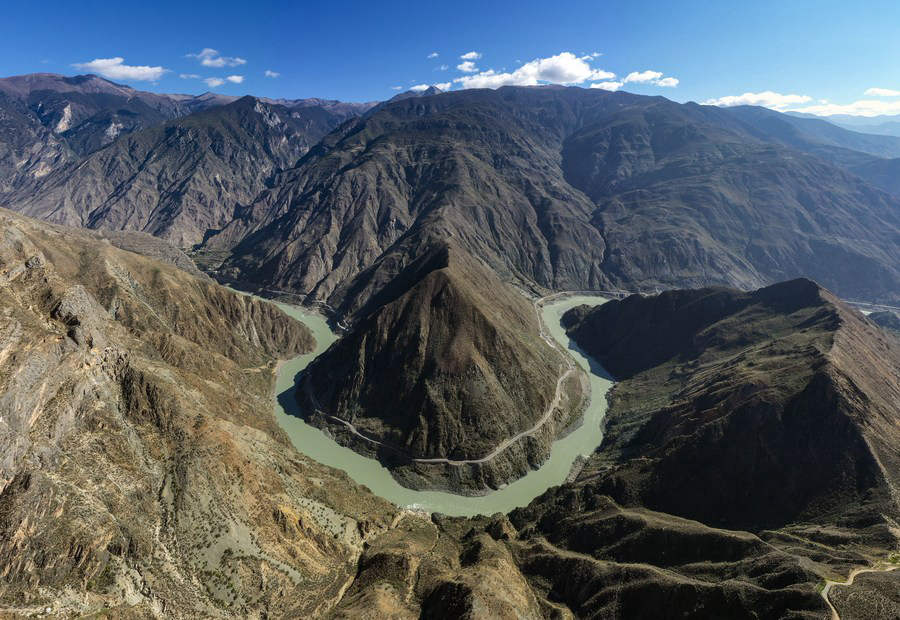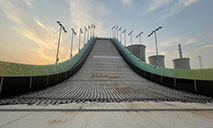China strengthens ecological protection as headwaters of Yangtze River see rising temperature

Aerial photo taken on Oct. 27, 2021 shows a bend of the Jinsha River, the upper section of the Yangtze River, in southwest China. (Xinhua/Jiang Wenyao)
The temperature of the headwaters of the Yangtze River, China's longest river, is rising due to global warming, and the Chinese government is taking multiple measures to cope with the problem.
Recent scientific research showed that from 1956 to 2016, the warming rate in the headwaters of the Yangtze River increased by 0.346 degrees Celsius per decade. The figure is about 1.4 times the rate of warming in China and twice the global rate.
Experts said that the rising temperature would have a series of impacts on the unique ecological environment of the area, which requires global attention and joint measures to deal with climate warming.
The headwaters of the Yangtze River stands on the Qinghai-Tibet Plateau, with an average elevation of over 4,500 meters. The plateau, known as "the roof of the world," is also the birthplace of the Yellow River, the second-longest river in the country, and the Lancang River (known as the Mekong River after it flows out of China).
The area of the three river sources has been dubbed "Asia's water tower," supplying water for nearly 3 billion people.
The temperature in the headwaters of the Yangtze River has shown a trend of fluctuating increase over the past decades, especially in the past 20 years, according to the research conducted by Changjiang River Scientific Research Institute.
The annual average temperature in the area in the past decade increased by 1.4 degrees Celsius, compared with that of the previous 40 years.
"Cold, high-altitude areas like the headwaters of the Yangtze River are more sensitive to the rising temperature," said Yuan Zhe, a senior engineer of the institute who participated in the research.
"The rapid rising temperature of the headwaters of the Yangtze River is mainly due to the overall climate change on the Qinghai-Tibet Plateau, as well as the growing global carbon dioxide emissions and the greenhouse effect," said Xu Ping, deputy chief engineer of the institute.
Researchers also found that the accelerating warming in the headwaters of the Yangtze River also has a clear influence on the plateau ecology.
Standing high at the altitude of over 5,000 meters, the Dongkemadi glacier is located at the source of a tributary of the Yangtze River.
"The Dongkemadi glacier has retreated by more than 200 meters in more than 10 years. It retreated into two glaciers in 2009," said He Xiaobo, a Northwest Institute of Eco-Environment and Resources researcher at the Chinese Academy of Sciences, who has been observing the glacier since 2005.
In 2020 alone, the two glaciers continued to retreat 10.1 and 15.7 meters, respectively.
Apart from glacier degradation, vegetation in the area has also been directly impacted by the rising temperature.
Researchers said that the glaciers might never recover until they disappear completely when the temperature reaches a certain threshold in the medium and long term. At the same time, the vegetation structure would be destroyed, bringing a series of ecological risks to the whole plateau, such as grassland desertification, soil erosion, animal and plant decrease and ecological deterioration.
To address the rising temperature of the headwaters of the Yangtze River and the Qinghai-Tibet Plateau, China has taken a series of actions -- protecting and restoring the ecological environment of the headwaters of the Yangtze River and limiting production and human activities that could damage the ecological environment.
In the area, about 7,000 herdsmen have become paid ecological conservators to reduce the impact of grazing in the area's ecology, according to Tashi, an official of the area's management committee.
"All human activities such as tourism and energy resources exploitation have been halted. Scientific research and ecological projects in this area must be subject to strict examination and approval," Tashi added.
Meanwhile, the country has vowed to attain a carbon dioxide emissions peak before 2030 and achieve carbon neutrality before 2060.
China is now the world's biggest investor in renewable energy, accounting for about 30 percent of the total global investment in the area each year since 2015.
In the first half of this year, China's renewable energy generating capacity increased remarkably, with the generating capacity of the photovoltaic power hiking by 20 percent and wind power rising by 10.9 percent over the same period last year, data from the National Energy Administration showed.
"The root cause of the accelerating warming of the area is global warming. It is not the responsibility of a single region, nor a single country, but a mission that requires the participation and efforts of the whole world," said Hu Jiajun, deputy director of the Water Resource Commission of the Yangtze River, under the Ministry of Water Resources.
Experts also called for a global response and joint measures to cope with global warming and strengthen ecological restoration and conservation in ecologically fragile areas such as the headwaters of the Yangtze River.
Photos
Copyright © 2021 People's Daily Online. All Rights Reserved.










